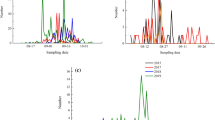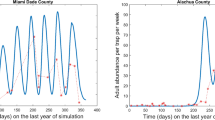Abstract
Field and laboratory evidence now suggests that the African armyworm, Spodoptera exempta, is specifically adapted for survival at low population densities, providing a new basis for understanding the significance of its phase polyphenism and migratory strategy. This conclusion allows deductions to be made as to the expected extent of displacement of flying moths from low and, when they occur as a result of impeded or inadequate dispersal of parent moths, high density populations. The proposed migratory strategy which depends on the genetic determination of flight potential also provides a framework for interpreting observed patterns of armyworm outbreaks through the season and in relation to rainfall. Traits associated with a low-density, “armyworm” strategy are shared by other Noctuids which may have similar life histories.
Résumé
Les données de laboratoire et de terrain montrent que la légionnaire africaine, Spodoptera exempta, est spécifiquement adaptée pour survivre dans les conditions de faible densité offrant ainsi une nouvelle structure de base pour comprendre la signification du polyphénisme de phase et la stratégie migratoire de cette espèce. Ceci nous permet de prédire l’étendue des déplacements migratoires des adultes chez les populations de faible densité de même que chez celles de forte densité où la dispersion de la génération précédente a été limitée. La stratégie migratoire proposée, fondée sur une détermination génétique du vol, offre aussi une nouvelle base pour interpréter les épidémies saisonnières, associées avec le phénomène des pluies chez la légionnaire. Les traits qui sont associés à la stratégie pendant les conditions de faible densité sont aussi rencontrés chez d’autres Noctuides qui partagent les mêmes modes de vie.
Similar content being viewed by others
References
Aidley D. J. (1974) Migratory capability of the African armyworm moth, Spodoptera exempta (Walker ). East Afr. agric. For. J. 40, 202–203.
Brown E. S., Betts E. and Rainey R. C (1969) Seasonal changes in distribution of the African armyworm, Spodoptera exempta (Wlk.) (Lep., Noctuidae), with special reference to eastern Africa. Bull. Ent. Res. 58, 661–728.
Davis M. A. (1980) Why are most insects short fliers? Evol. Theor. 5, 103–111.
Gatehouse A. G. (1986) Migration in the African army-worm Spodoptera exempta: genetic determination of migratory capacity and a new synthesis. In Insect Flight, Dispersal and Migration. (Edited by Danthanarayana W.), pp. 128–144. Springer Verlag, Heidelberg.
Gatehouse A. G. and Hackett D. S. (1980) A technique for studying flight behaviour of tethered Spodoptera exempta moths. Physiol. Ent. 5, 215–222.
Gatehouse A. G. and Woodrow K. P. (1987) Simultaneous monitoring of flight and oviposition of individual velvet-bean caterpillar moths (by Wales, Barfield & Leppla, 1985): a critique. Physiol. Ent., 12, 117–121.
Gruys P. (1970) Growth in Bupalus pinniarius (Lepidoptera: Geometridae) in relation to larval density. Verh. Rijksinst. Naturbeheer. 1, 1–127.
Gunn A. and Gatehouse A. G. (1985) Effects of larval and adult food and water uptake on reproduction in the African armyworm. Spodoptera exempta (Walker ) (Lepidoptera, Noctuidae). Physiol. Ent. 10, 53–63.
Gunn A. and Gatehouse A. G. (1986) The effect of adult feeding on lipid and protein reserves in African army-worm, Spodoptera exempta, moths before and during reproduction. Physiol. Ent. 11, 423–431.
Haggis M. J. (1984) Distribution, Frequency of Attack and Seasonal Incidence of the African Armyworm, Spodoptera exempta (Walk?) (Lep.: Noctuidae), with Particular Reference to Africa and South-western Arabia. Tropical Development and Research Institute, London. L69.
Hattingh C. C (1941) The biology and ecology of the armyworm (Laphygma exempta) and its control in South Africa. Dep. Agric. For. Sth Afr. Sci. Bull. No. 217.
Hébert P. D. N. (1983) Egg dispersal patterns and adult feeding behaviour in the Lepidoptera. Can. Ent. 115, 1477–1481.
Johnson C. G. (1976) Lability of the flight system: a context for functional adaptation. In Insect Flight (Edited by Rainey R. C), pp. 217–234. Royal Entomological Society of London Symposium No. 7. Blackwell, Oxford.
Nyirenda G. K. C (1985) Persistent populations of males of the African armyworm, Spodoptera exempta (Walker ) (Lepidoptera: Noctuidae) in Malawi. Bull. ent. Res. 75, 405–415.
Oku T. and Kobayashi T. (1978) Migratory behaviour and life cycle of noctuid moths (Insecta: Lepidoptera) with notes on recent status of migrant species in northern Japan. Bull. Tohoku Nat. Agric. Exp. Stn. 58, 97–209 (in Japanese: English summary).
Page W. W. (1985) Oocyte development in the African armyworm, Spodoptera exempta. M.Se. thesis, University of Wales.
Parker W. E. and Gatehouse A. G. (1985a) The effect of larval rearing conditions on flight performance in females of the African armyworm, Spodoptera exempta (Walker ) (Lepidoptera: Noctuidae). Bull. ent. Res. 75, 35–47.
Parker W. E. and Gatehouse A. G. (1985b) Genetic factors controlling flight performance and migration in the African armyworm moth, Spodoptera exempta (Walker ) (Lepidoptera: Noctuidae). Bull. ent. Res. 75, 49–63.
Pedgley D. E., Reynolds D. R., Riley J. R. and Tucker M. R. (1982) Flying insects reveal small-scale wind systems. Weather, Lond. 37, 295–306.
Rainey R. C (1985) Insect flight: new facts—and old fantasies? In Insect Locomotion. (Edited by Gewecke M. and Wendler G.), pp. 241–244. Verlag Paul Parey, Berlin.
Riley J. R., Reynolds D. R. and Farmery M. J. (1981) Radar observations of Spodoptera exempta, Kenya, March-April 1979. Miscellaneous Report No. 54. Centre for Overseas Pest Research (Overseas Development Administration), London.
Riley J. R., Reynolds D. R. and Farmery M. J. (1983) Observations of the flight behaviour of the armyworm moth, Spodoptera exempta, at an emergence site using radar and infra-red optical techniques. Ecol. Ent. 8, 395–418.
Rose D. J. W. (1975) Field development and quality changes in successive generations of Spodoptera exempta Wlk., the African armyworm. J. appl. Ecol. 12, 727–739.
Rose D. J. W. (1979) The significance of low-density populations of the African armyworm Spodoptera exempta (Walk.). Phil. Trans. R. Soc. B 287, 245–488.
Rose D. J. W. and Dewhurst C. F. (1979) The African armyworm, Spodoptera exempta—congregation of moths in trees before flight. Ent. exp. et appl. 26, 346–348.
Rose D. J. W., Page W. W., Dewhurst C. F., Riley J. R., Reynolds D. R., Pedgley D. E. and Tucker M. R. (1985) Downwind migration of the African armyworm moth, Spodoptera exempta, studied by mark-and-capture and by radar. Ecol. Ent. 10, 299–313.
Southwood T. R. E. (1977) Habitat, the template for ecological strategies? J. Anim. Ecol. 46, 337–365.
Southwood T. R. E. (1981) Ecological aspects of insect migration. In Animal Migration (Edited by Aidley D. J.), pp. 197–208. Society for Experimental Biology Seminar Series No. 13, Cambridge University Press, Cambridge.
Tucker M. R. (1983) Light-trap catches of African army-worm moths Spodoptera exempta (Walker ) (Lepidoptera: Noctuidae) in relation to rain and wind. Bull. ent. Res. 73, 315–319.
Tucker M. R. and Pedgley D. E. (1983) Rainfall and outbreaks of the African armyworm Spodoptera exempta (Walker ) (Lepidoptera: Noctuidae). Bull. ent. Res. 73, 195–199.
Tucker M. R., Mwandoto S. and Pedgley D. E. (1982) Further evidence for the windborne movement of army-worm moths, Spodoptera exempta, in East Africa. Ecol. Ent. 7, 463–473.
Whellan J. A. (1954) The African armyworm and its control. Rhod. agric. J. 51, 414–427.
Whellan J. A. (1960) Armyworm. Report of the Seventh Commonwealth Entomological Conference 6-15th July, 1960, London, pp. 267–268.
Woodrow K. P., Gatehouse A. G. and Davies D. A. (1987) The effect of larval phase on flight performance of African armyworm moths, Spodoptera exempta (Walker ) (Lepidoptera: Noctuidae). Bull. ent. Res. 77, 113–122.
Yarro J. G. (1982) The growth, development and survival of Spodoptera exempta (Walk.) (Lepidoptera: Noctuidae) on some selected grass species. Ph.D. thesis, University of Dar es Salaam, Tanzania.
Author information
Authors and Affiliations
Rights and permissions
About this article
Cite this article
Gatehouse, A.G. Migration and Low Population Density in Armyworm (Lepidoptera: Noctuidae) Life Histories. Int J Trop Insect Sci 8, 573–580 (1987). https://doi.org/10.1017/S1742758400022633
Received:
Published:
Issue Date:
DOI: https://doi.org/10.1017/S1742758400022633
Key Words
- Spodoptera exempta
- Noctuidae
- African armyworm
- flight
- migration
- dispersal
- phase polyphenism
- population density
- genetics of flight potential
- heritability
- evolution of migration
- life history strategies
- control




